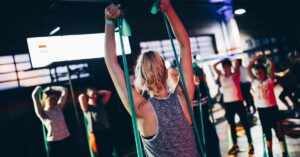Unlocking the Mind-Body Connection Through Movement and Exercise

Unlocking the Mind-Body Connection Through Movement and Exercise
Have you ever found yourself in a funk, feeling overwhelmed by the demands of daily life, only to step outside for a brisk walk and return feeling like a new person? The truth is, the relationship between our minds and bodies is more intricate than we often realize. Movement and exercise serve as the bridge that connects our physical selves with our mental states, providing a holistic approach to well-being. So, how do we truly unlock this powerful mind-body connection? In this exploration, we’ll delve into the science, the personal anecdotes, and the practical strategies that can enhance our understanding of this fascinating relationship.
The Science Behind Movement and Mental Health
To begin with, let’s dive into some of the research that supports the powerful connection between movement and mental health. Numerous studies point to the benefits of physical activity in reducing symptoms of anxiety and depression. For instance, a meta-analysis conducted by the American Psychological Association found that regular physical activity can significantly alleviate depressive symptoms. And it’s not just about the endorphins – those delightful chemicals released during exercise. It turns out that movement can also promote neuroplasticity, the brain’s ability to reorganize itself by forming new neural connections.
Consider the case of Dr. John Ratey, a clinical associate professor of psychiatry at Harvard Medical School, who emphasizes that exercise is a miracle grow for the brain. He argues that physical activity helps us think better, feel better, and learn better. I remember listening to one of his lectures where he passionately claimed—much to the amusement of the audience—that “if exercise could be put in a pill, it would be the most prescribed medication in the world.” His enthusiasm was infectious, and it struck me that many people still underestimate the power of a simple jog or a dance session.
Movement as a Form of Mindfulness
When we talk about mindfulness, we often envision sitting cross-legged on a yoga mat, focusing on our breath. But what if I told you that movement could be a form of mindfulness too? Engaging in activities such as yoga, tai chi, or even a slow, deliberate walk can help ground us in the present moment. As we move, we become more aware of our bodies, our breath, and our surroundings—an experience that can be both calming and invigorating.
In my own experience, I often find that a gentle stretch or a few sun salutations in the morning set a positive tone for the day. It’s like pressing the reset button on my mind. There’s something about flowing through those poses that invites clarity and focus. It’s almost as if the body and mind hold hands, gracefully waltzing through the chaos of life.
Exercise: A Natural Antidepressant
If you’ve ever felt a natural high after a workout, you’re not alone. Exercise has been dubbed a natural antidepressant, and for good reason. The release of endorphins, often referred to as “feel-good” hormones, can help combat feelings of sadness and anxiety. But the benefits don’t stop there. Regular physical activity can also improve sleep, boost self-esteem, and enhance cognitive function.
Let’s take a moment to reflect on how many of us have turned to exercise during challenging times. I can vividly recall a particularly stressful period in my life when I discovered the therapeutic effects of running. Each mile felt like shedding layers of worry and doubt. It was as if the rhythm of my feet hitting the pavement drowned out the noise in my head. Every runner has their own story; perhaps you’re someone who found solace in the repetitiveness of cycling or the camaraderie of a team sport.
Unlocking Creativity Through Movement
Interestingly, movement can also serve as a catalyst for creativity. Ever notice how some of your best ideas strike when you’re on a walk? There’s a fascinating concept known as the “creative pause,” where stepping away from a task and engaging in physical activity can lead to breakthroughs. A study published in the Journal of Experimental Psychology found that individuals who walked while brainstorming came up with more creative ideas than those who remained seated.
I like to think of this as a mental refresh button. In fact, I often schedule walking meetings—an unconventional but surprisingly effective way to spark creativity and collaboration. Next time you find yourself stuck in a mental rut, try taking a stroll. Who knows? You might just stumble upon the next great idea.
The Role of Breath in Movement
Now, let’s pivot to the breath, that often-overlooked companion to movement. Our breath not only sustains us physically but also plays a crucial role in regulating our emotional states. Breathing techniques can enhance the benefits of exercise by calming the nervous system and promoting relaxation. Incorporating breathwork into your routine can transform an ordinary workout into a deeply restorative experience.
In my yoga classes, I’ve often heard instructors remind us to focus on our breath, guiding us to inhale deeply and exhale fully. It seems simple, yet the impact is profound. When we align our breath with our movements, we create a symphony of mind and body—a harmonious dance that can alleviate stress and enhance overall well-being. Remember, it’s not just about lifting weights or running miles; it’s about connecting with ourselves on a deeper level.
Finding the Right Movement for You
As we explore the mind-body connection, it’s essential to emphasize that movement is not a one-size-fits-all approach. What works for one person may not resonate with another. Some thrive in the structured environment of a gym, while others find joy in the freedom of outdoor activities. The key is to experiment and discover what feels right for you.
Here are a few suggestions for finding your groove:
- **Try Different Activities**: From dance to martial arts, explore various forms of movement to find what resonates with you.
- **Listen to Your Body**: Pay attention to how different types of exercise make you feel. Your body often knows what it needs.
- **Join a Group**: Engaging in group activities fosters a sense of community and can make exercising feel more enjoyable.
- **Set Realistic Goals**: Start small and gradually increase intensity. Celebrating small wins can boost motivation.
In my own journey, I’ve dabbled in everything from Zumba to rock climbing (which, let me tell you, was a humbling experience). Each activity brought its own flavor to the table, and I learned something new about myself with every attempt. Don’t be afraid to step outside your comfort zone; you might just discover a hidden passion.
Creating a Sustainable Movement Practice
Now that we’ve established the benefits of movement, let’s talk about sustainability. Many of us embark on fitness journeys with the best of intentions, only to find ourselves burning out or losing motivation. The trick is to create a sustainable practice that fits seamlessly into your life.
One way to foster sustainability is to integrate movement into your daily routine. Instead of viewing exercise as a chore, think of it as a necessary part of your day. Take the stairs instead of the elevator, walk or bike to work, or schedule short movement breaks throughout your day. Small changes can add up, leading to significant shifts in your overall well-being.
Moreover, remember that it’s okay to have off days. I’ve certainly had my fair share of “couch potato” moments where binge-watching my favorite series took precedence over hitting the gym. Life happens, and that’s perfectly normal. The key is to approach movement with a sense of curiosity and playfulness, rather than rigidity and pressure.
Mindfulness and Movement: A Personal Practice
As I reflect on my own journey with movement, I can’t help but share my love for hiking. There’s something about being surrounded by nature that elevates my spirit. The crunch of leaves underfoot, the fresh scent of pine, and the breathtaking views all contribute to a profound sense of connection—not just to the earth, but to myself. I often find clarity on the trail, as if the act of moving forward mirrors my own personal growth. It’s a reminder that, just like the terrain, life has its ups and downs.
Incorporating mindfulness into my hikes has transformed the experience. Rather than rushing through the trails, I take time to pause, breathe, and soak in the beauty around me. This practice of being fully present allows me to appreciate the journey as much as the destination—a lesson that resonates far beyond the trails.
Building a Support System
As we navigate our movement journeys, it’s essential to build a support system. Surrounding yourself with like-minded individuals can provide motivation, encouragement, and accountability. Whether it’s a workout buddy, a fitness class, or an online community, having a support system can make all the difference.
I recall a time when I joined a local running club. Initially, I was hesitant—what if I couldn’t keep up? But the camaraderie of fellow runners was infectious. We celebrated each other’s milestones, from completing our first 5K to sharing post-run snacks (a crucial part of the experience, if you ask me). There’s something incredibly uplifting about being part of a community that shares your passion for movement.
The Mind-Body Connection: A Lifelong Journey
Ultimately, unlocking the mind-body connection through movement and exercise is a lifelong journey. It’s not about perfection or adhering to rigid standards; it’s about discovering what feels good for you, embracing the process, and cultivating a sense of joy in movement. Each step, each breath, and each moment spent in motion contributes to a richer, more fulfilling life.
As I wrap up this exploration, I encourage you to take the plunge. Try something new, reconnect with an old favorite, or simply take a moment to breathe deeply and appreciate your body. After all, movement is not just a means to an end; it’s a celebration of what our bodies can do and a reminder of the profound connection we share with ourselves.
Conclusion: Embrace the Journey
In closing, I leave you with this thought: the journey of unlocking the mind-body connection through movement is as unique as each of us. Whether you find solace in a quiet yoga session, the thrill of a high-intensity workout, or the tranquility of a nature walk, embrace it. Allow yourself the grace to explore, to stumble, and to grow. In doing so, you’ll uncover not only the benefits of movement but also a deeper understanding of yourself.
So, the next time you’re feeling stuck or overwhelmed, remember that movement awaits as a powerful ally—a friend ready to lift your spirits and connect you to the vibrant tapestry of life. Now, go out there and dance, jog, stretch, or hike your way to a healthier, happier you!





